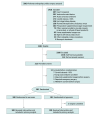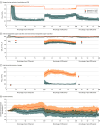Intraoperative Oxygen Treatment, Oxidative Stress, and Organ Injury Following Cardiac Surgery: A Randomized Clinical Trial
- PMID: 39110454
- PMCID: PMC11307166
- DOI: 10.1001/jamasurg.2024.2906
Intraoperative Oxygen Treatment, Oxidative Stress, and Organ Injury Following Cardiac Surgery: A Randomized Clinical Trial
Abstract
Importance: Liberal oxygen (hyperoxia) is commonly administered to patients during surgery, and oxygenation is known to impact mechanisms of perioperative organ injury.
Objective: To evaluate the effect of intraoperative hyperoxia compared to maintaining normoxia on oxidative stress, kidney injury, and other organ dysfunctions after cardiac surgery.
Design, setting, and participants: This was a participant- and assessor-blinded, randomized clinical trial conducted from April 2016 to October 2020 with 1 year of follow-up at a single tertiary care medical center. Adult patients (>18 years) presenting for elective open cardiac surgery without preoperative oxygen requirement, acute coronary syndrome, carotid stenosis, or dialysis were included. Of 3919 patients assessed, 2501 were considered eligible and 213 provided consent. Of these, 12 were excluded prior to randomization and 1 following randomization whose surgery was cancelled, leaving 100 participants in each group.
Interventions: Participants were randomly assigned to hyperoxia (1.00 fraction of inspired oxygen [FiO2]) or normoxia (minimum FiO2 to maintain oxygen saturation 95%-97%) throughout surgery.
Main outcomes and measures: Participants were assessed for oxidative stress by measuring F2-isoprostanes and isofurans, for acute kidney injury (AKI), and for delirium, myocardial injury, atrial fibrillation, and additional secondary outcomes. Participants were monitored for 1 year following surgery.
Results: Two hundred participants were studied (median [IQR] age, 66 [59-72] years; 140 male and 60 female; 82 [41.0%] with diabetes). F2-isoprostanes and isofurans (primary mechanistic end point) increased on average throughout surgery, from a median (IQR) of 73.3 (53.1-101.1) pg/mL at baseline to a peak of 85.5 (64.0-109.8) pg/mL at admission to the intensive care unit and were 9.2 pg/mL (95% CI, 1.0-17.4; P = .03) higher during surgery in patients assigned to hyperoxia. Median (IQR) change in serum creatinine (primary clinical end point) from baseline to postoperative day 2 was 0.01 mg/dL (-0.12 to 0.19) in participants assigned hyperoxia and -0.01 mg/dL (-0.16 to 0.19) in those assigned normoxia (median difference, 0.03; 95% CI, -0.04 to 0.10; P = .45). AKI occurred in 21 participants (21%) in each group. Intraoperative oxygen treatment did not affect additional acute organ injuries, safety events, or kidney, neuropsychological, and functional outcomes at 1 year.
Conclusions: Among adults receiving cardiac surgery, intraoperative hyperoxia increased intraoperative oxidative stress compared to normoxia but did not affect kidney injury or additional measurements of organ injury including delirium, myocardial injury, and atrial fibrillation.
Trial registration: ClinicalTrials.gov Identifier: NCT02361944.
Conflict of interest statement
Figures



Comment on
-
Is Too Much Oxygen a Bad Thing?JAMA Surg. 2024 Oct 1;159(10):1116. doi: 10.1001/jamasurg.2024.2921. JAMA Surg. 2024. PMID: 39110430 Free PMC article. No abstract available.
References
-
- LaPar DJ, Speir AM, Crosby IK, et al. ; Investigators for the Virginia Cardiac Surgery Quality Initiative . Postoperative atrial fibrillation significantly increases mortality, hospital readmission, and hospital costs. Ann Thorac Surg. 2014;98(2):527-533. doi: 10.1016/j.athoracsur.2014.03.039 - DOI - PubMed
Publication types
MeSH terms
Associated data
Grants and funding
LinkOut - more resources
Full Text Sources
Medical
Miscellaneous

